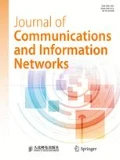Abstract
Integrated satellite and terrestrial networks can be used to solve communication problems in natural disasters, forestry monitoring and control, and military communication. Unlike traditional communication methods, integrated networks are effective solutions because of their advantages in communication, remote sensing, monitoring, navigation, and all-weather seamless coverage. Monitoring, urban management, and other aspects will also have a wide range of applications. This study first builds an integrated network overlay model, and divides the satellite network into two categories: terrestrial network end users and satellite network end users. The energy efficiency, throughput, and signal-to-noise ratio (SINR) are deduced and analyzed. In this paper, we discuss the influence of various factors, such as transmit power, number of users, size of the protected area, and terminal position, on energy efficiency and SINR. A satellite-sharing scheme with a combination of the user location and an exclusion zone with high energy efficiency and anti-jamming capability is proposed to provide better communication quality for end users in integrated satellite and terrestrial networks.
Similar content being viewed by others
References
G. N. Kamga, M. Sadek, S. Aissa. Adaptive handoff for multi-antenna mobile satellite systems with ancillary terrestrial component [C]//IEEE International Conference on Communications, Kuala Lumpur, 2016.
Y. Fujino, A. Miura, N. Hamamoto, et al. Satellite terrestrial integrated mobile communication system as a disaster countermeasure [C]//URSI General Assembly and Scientific Symposium, Istanbul, 2011: 1–4.
S. Liu, F. Qin, Z. Gao, et al. LTE-satellite: Chinese proposal for satellite component of IMT-Advanced System [J]. China Communication, 2013, 10(10): 47–64.
A. Orsino, G. Araniti, P. Scopelliti, et al. Optimal subgroup configuration for multicast services over 5G-satellite systems [C]//IEEE International Symposium on Broadband Multimedia Systems and Broadcasting, Cagliari, 2017.
X. M. Zhu, C. X. Jiang, L. L. Kuang, et al. Non-orthogonal multiple access based integrated terrestrial-satellite networks [J]. IEEE Journal on Selected Areas in Communications, 2017, 35(10): 2253–2267.
V. Deslandes, J. Tronc, A. L. Beylot. Analysis of interference issues in integrated satellite and terrestrial mobile systems [C]//5th Advanced Satellite Multimedia Systems Conference and the 11th Signal Processing for Space Communications Workshop, Cagliari, 2010: 256–261.
G. Giambene, V. A. Le, T. Bourgeau, et al. Soft frequency reuse schemes for heterogeneous LTE systems [C]//IEEE International Conference on Communications, London, 2015: 3161–3166.
H. Xie, B. Wang, F. Gao, et al. A full-space spectrum-sharing strategy for massive MIMO cognitive radio system [J]. IEEE Journal on Selected Areas in Communications, 2016, 34(10): 2537–2549.
U. Park, H. W. Kim, D. S. Oh, et al. Performance analysis of dynamic resource allocation for interference mitigation in integrated satellite and terrestrial systems [C]//International Conference on Next Generation Mobile Applications, Services and Technologies, Cambridge, 2016: 217–221.
M. Sheng, Y. Wang, J. Li, et al. Toward a flexible and reconfigurable broadband satellite network: resource management architecture and strategies [J]. IEEE Wireless Communications, 2017, 24(4): 127–133.
M. Jia, X. Gu, Q. Guo, et al. Broadband hybrid satellite-terrestrial communication systems based on cognitive radio toward 5G [J]. IEEE Wireless Communications, 2016, 23(6): 96–106.
R. Vannithamby, S. Talwar. Towards green and soft [M]. JohnWiley & Sons, Ltd, 2016: 53–77.
3GPP TR 36.942 V10.3.0. Technical specification group radio access network, evolved universal terrestrial radio access (E-UTRA), radio frequency (RF) system scenarios (release 10). 2012: 14-15.
Author information
Authors and Affiliations
Corresponding author
Additional information
This work is supported by the National Natural Science Foundation of China (Nos. 61671183, 61771163, 91438205).
Min Jia was born in 1982. She received her M.Sc. degree in information and communication engineering from Harbin Institute of Technology (HIT) in 2006, and her Ph.D. degree from SungKyungKwan University of Korea and HIT in 2010. She is currently an associate professor and Ph.D. supervisor at the Communication Research Center and School of Electronics and Information Engineering of HIT. Her research interests focus on advanced mobile communication technology and non-orthogonal transmission scheme for 5G, cognitive radio, digital signal processing, machine learning and broadband satellite communications. (Email: jiamin@hit.edu.cn )
Ximu Zhang was born in 1993. She received her M.Sc. degree in Harbin Institute of Technology (HIT), in 2017. She is currently a Ph.D. candidate in Communication Research Center and School of Electronics and Information Engineering of HIT. Her research interests include broadband satellite communications and heterogeneous cloud radio access network. (Email: 17B905006@stu.hit.edu.cn)
Xuemai Gu [corresponding author] was born in 1957. He received his M.Sc. and Ph.D. degrees from the Department of Information and Communication Engineering of HIT in 1985 and 1991, respectively. He is currently a professor and president of the Graduate School of HIT. His research interests focus on integrated and hybrid satellite and terrestrial communications and broadband multimedia communication technique. (Email: guxuemai@hit.edu.cn)
Xiaofeng Liu was born in 1961. He is currently a professor in the School of Electronic and Information Engineering of HIT. His research interests focus on satellite communications and broadband multimedia communication technique. (Email: liuxiaofeng@ hit.edu.cn)
Qing Guo was born in 1964. He received his M.Sc. and Ph.D. from Beijing University of Posts and Telecommunications and HIT in 1985 and 1998, respectively. He is currently a professor and president at the School of Electronics and Information Engineering, HIT. His research interests focus on satellite communications and broadband multimedia communication techniques. (Email: qguo@hit.edu.cn)
Rights and permissions
About this article
Cite this article
Jia, M., Zhang, X., Gu, X. et al. Joint UE Location Energy-Efficient Resource Management in Integrated Satellite and Terrestrial Networks. J. Commun. Inf. Netw. 3, 61–66 (2018). https://doi.org/10.1007/s41650-018-0006-5
Received:
Accepted:
Published:
Issue Date:
DOI: https://doi.org/10.1007/s41650-018-0006-5




